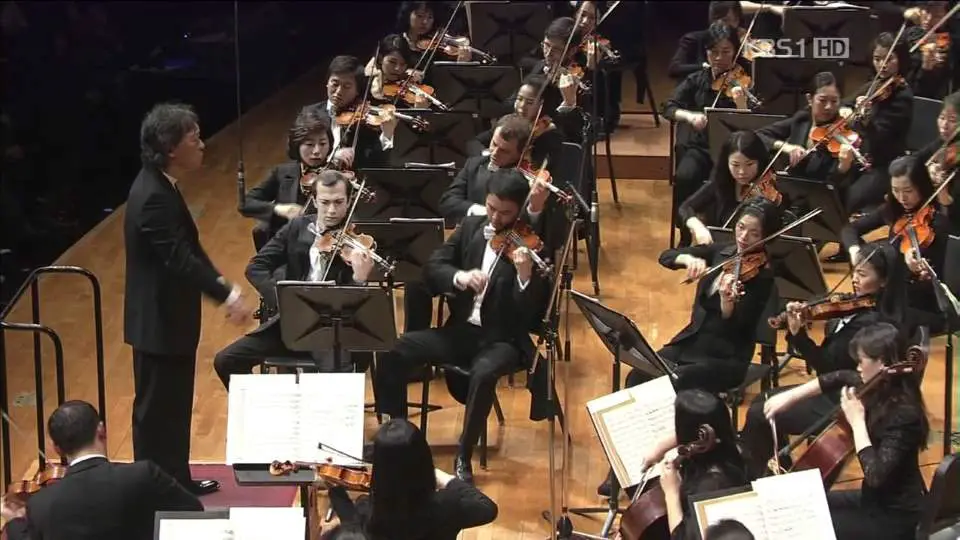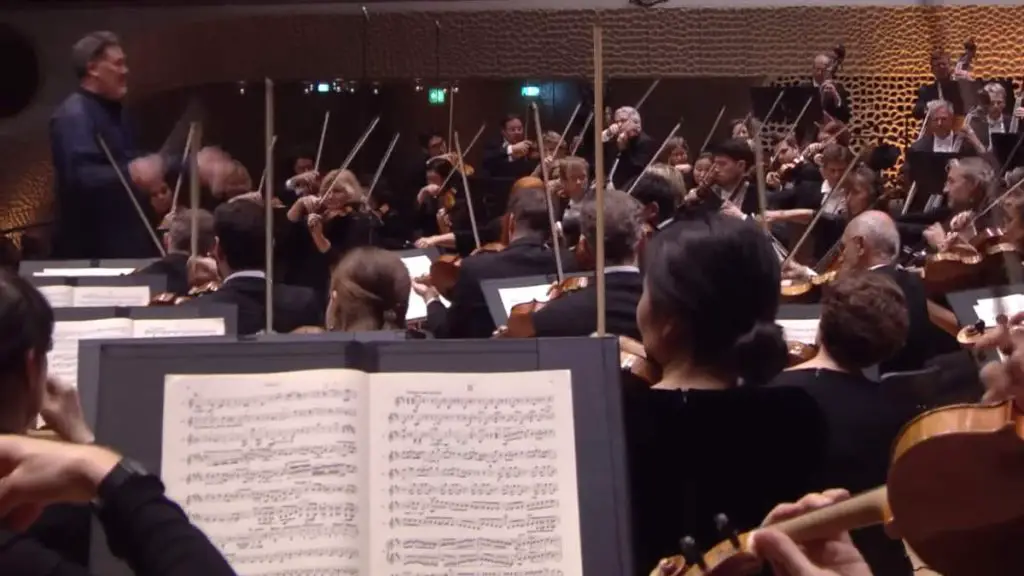Conducted by Herbert von Karajan, the Wiener Philharmoniker (Vienna Philharmonic Orchestra) plays Pyotr Ilyich Tchaikovsky’s Symphony No. 6 in B minor, Op. 74, commonly known as the Pathétique Symphony. It is the final completed symphony of the Russian composer. Tchaikovsky dedicated the Pathétique to his nephew, Vladimir “Bob” Davydov, whom he greatly admired.
Written between February and the end of August 1893, the work premiered in Saint Petersburg in October 1893, just over a week before the composer’s death. The performance was conducted by the composer himself.
Tchaikovsky’s Symphony No. 6 “Pathétique”
Tchaikovsky’s Symphony No. 6 is one of the most personal and emotionally intense works in the symphonic repertoire. Written in 1893, it was the last symphony the composer completed before his death, premiering just nine days before he passed away. This timing, coupled with the symphony’s profound emotional depth, has led to much speculation about its autobiographical nature and whether it serves as a musical testament to the inner turmoil and struggles Tchaikovsky faced.
The Russian title of the symphony, Патетическая (Patetitčeskaja), is a better translation of “passionate” or “emotional” in English, not “arousing pity,” but it is a word reflective of a touch of concurrent suffering. Tchaikovsky considered calling it Программная (Programmnaya or “Programme Symphony”) but realized that would encourage curiosity about the programme, which he did not want to reveal.
According to his brother Modest, he suggested the Patetitčeskaja title, which was used in early editions of the symphony; there are conflicting accounts about whether Tchaikovsky liked the title, but in any event, his publisher chose to keep it and the title remained. Its French translation Pathétique is generally used in French, Spanish, English, German, and other languages. It was published in reduction by Jurgenson of Moscow in 1893 and by Robert Forberg of Leipzig in 1894.
Musically, Tchaikovsky departed from the traditional symphonic form in the Pathétique. Instead of ending on a triumphant or uplifting note, the symphony concludes in a somber and introspective manner, leaving listeners in a contemplative state. This unexpected structure contributes to the work’s enduring fascination and its reputation as a groundbreaking piece in the Romantic era’s symphonic landscape.
Tchaikovsky himself believed he had poured more of himself into this symphony than any of his previous works. The depth of feeling and innovation in its structure and thematic development has ensured its place as a cornerstone of the orchestral repertoire, with audiences and musicians alike finding fresh insights and emotional resonance with each encounter.
Tchaikovsky’s final symphony explores the metaphysics of death, musically contrasting the idealism of humankind and our naive dreams of transcendence with our pathetic material condition, the fact that we are made of flesh and blood and that we will all die. The composer hinted to his friends and admirers that the work might contain secret messages, but he never told them what they were. “Let them guess,” he said.
What caused the most guessing is an obvious quotation from the Russian Orthodox Requiem just after the climax of the first movement. This reference to a sacred ritual is paired, at the end of the fourth movement, with a symphonic enactment of the actual experience of death.
The orchestra articulates, through morendo dynamics and the darkest instrumental coloring possible, the dying of the light. Ultimately, however, death is unknowable, and the structure of each of the movements is thus as irrational as its subject matter. Conventional forms are shunned as are conventional harmonic patterns. Even the movement between tonal areas or keys is unusual: Rather than using fifths, or fourths, or even thirds, Tchaikovsky moves between keys related by semitone, lending a leaden effect to the proceedings.
And then there are the weird references to fanfares, waltzes, and marches patchwork of half-remembered musical tropes that suggest the score is a collection of deathbed memories. Each of these references is distorted and rendered strange. The second movement, for example, is a waltz with five beats to the measure instead of the familiar three.
Tchaikovsky was pleased with the “Pathétique,” and told his publisher that he was extremely proud of himself for assembling such a gorgeous work. It was composed during a wonderful time in his life when he had no sense it was about to end. During an outing to the theater in his final week, he was disheartened when the conversation with his brother and their friends turned grim. He changed the topic, declaring, in the flush of the success of the “Pathétique,” that he was certain he would “live a long time.”
Movements
The symphony contains four movements:
- Adagio – Allegro non troppo (E minor – B minor – D major – D minor – C-sharp major – B minor – B major)
- Allegro con grazia (D major – B minor – D major)
- Allegro molto vivace (G major – E major – G major – D major – G major)
- Finale: Adagio lamentoso – Andante (B minor – D major – C major – B minor) Ending in B minor, this symphony is the only one ending in a minor key among all the symphonies by Tchaikovsky.
1. Adagio – Allegro non troppo
The first movement of Tchaikovsky’s Symphony No. 6, “Pathétique,” is marked “Adagio – Allegro non troppo” and immediately sets the stage for the deeply emotional journey of the entire symphony. It begins with a somber and brooding introduction, characterized by its dark, lower strings. This introduction gradually builds in tension, eventually giving way to the main themes of the movement.
The primary theme, introduced by the woodwinds, is both lyrical and melancholic. It is expansive and highly expressive, encapsulating the deep emotion that Tchaikovsky weaves throughout the symphony. As the movement progresses, this theme undergoes various transformations, being passed among different sections of the orchestra and experienced in contrasting dynamics and moods.
A secondary, more rhythmic, and march-like theme provides contrast to the lyrical nature of the first theme. This theme, too, undergoes various transformations, bringing a sense of drama and tension to the movement.
Throughout this first movement, Tchaikovsky masterfully manipulates the orchestra’s full range, creating vast contrasts between moments of intimate delicacy and sweeping grandeur. His use of harmonies is both rich and poignant, contributing to the movement’s overall sense of yearning and introspection.
The movement concludes in a manner that’s true to its beginning, gradually descending into a quieter dynamic, leaving listeners in a state of reflection, seamlessly setting the stage for the subsequent movements of the symphony.
2. Allegro con graziao
The second movement is distinctive and intriguing in its character. Marked “Allegro con grazia,” it possesses a waltz-like quality, but with an unconventional twist: it’s written in 5/4 time, as opposed to the traditional 3/4 time signature commonly associated with waltzes. This unusual choice imparts a slightly off-kilter, almost limping feel to the rhythm, which adds to the movement’s unique charm.
Melodically, the movement offers a sense of lightness and elegance, providing a contrast to the weightier first movement. The main theme, introduced by the strings, is graceful and lilting, dancing throughout the orchestra. However, beneath this seemingly serene surface, there’s a touch of melancholy, a subtle reminder of the symphony’s overall emotional depth.
Midway through the movement, the mood shifts as Tchaikovsky introduces a more introspective, minor-key section. This portion is characterized by its expressive string melodies, further enriching the emotional landscape of the movement.
As the movement progresses towards its conclusion, the initial waltz theme makes a return, leading the listener back to its graceful rhythms, before ending softly, almost like a fleeting memory of a dance. The delicate balance Tchaikovsky strikes between elegance and underlying emotion in this movement showcases his profound mastery in evoking nuanced moods and atmospheres.
3. Allegro molto vivace
The third movement of Tchaikovsky’s Symphony No. 6 provides a marked shift in energy and mood from the previous segments. Marked “Allegro molto vivace,” this movement is characterized by its vibrant rhythms and spirited momentum, often likened to a scherzo or march.
From the outset, the music bursts forth with driving rhythms, punctuated by bright woodwind and brass flourishes. The predominant theme is vigorous and animated, propelled by insistent string passages and accented by the orchestra’s full might. It brings a sense of optimism and vitality, offering a stark contrast to the more contemplative and somber moods of the surrounding movements.
As the movement develops, Tchaikovsky introduces contrasting sections where the music becomes lighter, allowing the woodwinds and strings to engage in playful exchanges. These moments provide brief respites from the movement’s overarching dynamism, showcasing the composer’s ability to weave intricate textures and dialogues within the orchestra.
One of the most memorable features of this movement is its conclusion. The exhilarating momentum builds towards a climax that many listeners, especially during initial hearings, might anticipate as the symphony’s grand finale. In fact, during performances, it’s not uncommon for audiences to burst into applause at this point, mistaking it for the symphony’s end, given its triumphant and rousing character.
However, Tchaikovsky has a deeper emotional journey in store, as the powerful close of the third movement sets the stage for the profound introspection and melancholy of the fourth and final movement.
4. Finale: Adagio lamentoso – Andante
The finale of Tchaikovsky’s Symphony No. 6 is a profound departure from the triumphant energy of the third movement. Marked “Adagio lamentoso – Andante,” it commences with a deep sense of melancholy and introspection, plunging the listener into an emotional realm that is both profound and heart-wrenching.
From the onset, somber string melodies emerge, weaving a tapestry of sorrow and contemplation. This is music of raw emotion, a soul laid bare, reflecting perhaps Tchaikovsky’s own internal struggles and feelings. The mood is introspective, the melodies filled with longing, and the harmonies tinged with a sense of inevitable fate.
As the movement progresses, there are brief moments where the music tries to rise, seeking solace or perhaps a reprieve from its own weight. But these moments are transient, and the overarching lament returns, drawing the listener deeper into its emotive grasp.
One of the most poignant aspects of this movement is its conclusion. Rather than ending on a note of hope or resolution, the music gradually fades, the instruments thinning out to a sparse texture. The symphony concludes with quiet, hushed tones, leaving an atmosphere of unresolved sorrow and profound stillness.
This introspective ending is particularly moving given the symphony’s placement in Tchaikovsky’s life, being his final completed work before his death. It’s a testament to the composer’s genius that he was able to craft music that so deeply resonates with human emotion, leaving listeners with a sense of shared humanity and connection to the depths of the human soul.
Sources
- Symphony No. 6 (Tchaikovsky) on Wikipedia

